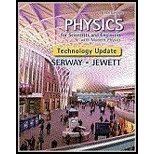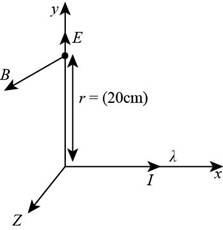
Concept explainers
(a)
The electric field the rod creates at the point
(a)
Answer to Problem 6P
The electric field the rod creates at the point
Explanation of Solution
Given info: The linear density of the rod is
The value of permittivity of free space is
The figure given below shows the location of the thin rod with respect to axis.

Figure (1)
The formula for the electric field due to long wire is,
Here,
Substitute
Conclusion:
Therefore, the electric field the rod creates at the point
(b)
The magnetic field the rod creates at the point
(b)
Answer to Problem 6P
The magnetic field the rod creates at the point
Explanation of Solution
Given info: The linear density of the rod is
The value of the permeability constant is
The expression for the current in the wire is,
Here,
Substitute
Thus, the current in the wire is
The formula for the magnetic flux due to wire is,
Here,
Substitute
Conclusion:
Therefore, the magnetic field the rod creates at the point
(c)
The force exerted on an electron at point
(c)
Answer to Problem 6P
The force exerted on an electron at point
Explanation of Solution
Given info: The linear density of the rod is
The charge on an electron is
The Lorentz force on the electron is,
Here,
Substitute
Conclusion:
Therefore, the force exerted on an electron at point
Want to see more full solutions like this?
Chapter 34 Solutions
Bundle: Physics for Scientists and Engineers with Modern Physics, Loose-leaf Version, 9th + WebAssign Printed Access Card, Multi-Term
- The construction of a water pistol is shown in the figure below. The cylinder with cross-sectional area A₁ is filled with water and when the piston is pushed (by pulling the trigger), water is forced out the tube with cross-sectional area A2. The radius of the cylinder and tube are, respectively, 1.30 cm and 1.10 mm, and the center of the tube is a height h = 3.00 cm above the center of the cylinder. (Assume atmospheric pressure is 1.013 × 105 Pa.) A2 A₁ (a) If the pistol is fired horizontally at a height of 1.30 m, determine the time interval (in s) required for water to travel from the nozzle to the ground. Neglect air resistance. (No Response) s (b) If the desired range of the stream is 7.50 m, with what speed ✓2 (in m/s) must the stream leave the nozzle? (No Response) m/s (c) At what speed v₁ (in m/s) must the plunger be moved to achieve the desired range? (No Response) m/s (d) What is the pressure (in Pa) at the nozzle? (No Response) Pa (e) Find the pressure (in Pa) needed in the…arrow_forwardA high-speed lifting mechanism supports a(n) 700-kg object with a steel cable that is 34.0 m long and 4.00 cm² in cross-sectional area. (a) Determine the elongation of the cable. (Enter your answer to at least two decimal places.) (No Response) mm (b) By what additional amount does the cable increase in length if the object is accelerated upwards at a rate of 2.5 m/s²? (No Response) mm (c) What is the greatest mass that can be accelerated upward at 2.5 m/s² if the stress in the cable is not to exceed the elastic limit of the cable, which is 2.2 × 108 Pa? (No Response) kgarrow_forwardA square metal sheet 2.5 cm on a side and of negligible thickness is attached to a balance and inserted into a container of fluid. The contact angle is found to be zero, as shown in Figure a, and the balance to which the metal sheet is attached reads 0.42 N. A thin veneer of oil is then spread over the sheet, and the contact angle becomes 180°, as shown in Figure b. The balance now reads 0.41 N. What is the surface tension of the fluid? x Your response differs from the correct answer by more than 10%. Double check your calculations. N/m a barrow_forward
- A helium-filled balloon (whose envelope has a mass of m₁ = 0.260 kg) is tied to a uniform string of length l = 2.70 m and mass m = 0.050 6 kg. The balloon is spherical with a radius of r = 0.399 m. When released in air of temperature 20°C and density Pair = 1.20 kg/m³, it lifts a length h of string and then remains stationary as shown in the figure below. We wish to find the length of string lifted by the balloon. He (a) When the balloon remains stationary, what is the appropriate analysis model to describe it? Oa particle in equilibrium model a particle under constant acceleration model a particle under constant velocity model the ideal fluid model (b) Write a force equation for the balloon from this model in terms of the buoyant force B, the weight F of the balloon, the weight Fe of the helium, and the weight F of the segment of string of length h. (Use any variable or symbol stated above along with the following as necessary: π. Follow the sign convention that upward is the positive…arrow_forwardAssume that if the shear stress in steel exceeds about 4.00 × 108 N/m², the steel ruptures. (a) Determine the shearing force necessary to shear a steel bolt 1.50 cm in diameter. (No Response) N (b) Determine the shearing force necessary to punch a 1.50-cm-diameter hole in a steel plate 0.650 cm thick. (No Response) Narrow_forward= = You are preparing your house for a party with your classmates and friends, and want to set up an impressive light display to entertain them. From your study of fluids, you have come up with the idea based on the water flowing from the tank in the figure. You set up the tank as shown in the figure, filled to a depth h 1.15 m, and sitting on a stand of height { 0.300 m. You punch a hole in the tank at a height of Y1 = 0.102 m above the stand. (Ignore the thickness of the tank in your calculation.) You want to punch a second hole higher on the tank so that the streams of water from the two holes arrive at the same position on the table, in a catch basin at a distance d from the right edge of the stand. A pump will continuously carry water from the catch basin back up to the top of the tank to keep the water level fixed. Then, you will use laser pointers on the left side of the tank to light the two streams of water, which will capture the light (see the section on total internal…arrow_forward
- A square metal sheet 2.5 cm on a side and of negligible thickness is attached to a balance and inserted into a container of fluid. The contact angle is found to be zero, as shown in Figure a, and the balance to which the metal sheet is attached reads 0.42 N. A thin veneer of oil is then spread over the sheet, and the contact angle becomes 180°, as shown in Figure b. The balance now reads 0.41 N. What is the surface tension of the fluid? N/m aarrow_forwardSucrose is allowed to diffuse along a 12.0-cm length of tubing filled with water. The tube is 6.1 cm² in cross-sectional area. The diffusion coefficient is equal to 5.0 × 10-10 m²/s, and 8.0 × 10−14 x transported along the tube in 18 s. What is the difference in the concentration levels of sucrose at the two ends of the tube? .00567 kg isarrow_forwardneed help part a and barrow_forward
- Complete the table below for spherical mirrors indicate if it is convex or concave. Draw the ray diagrams S1 10 30 S1' -20 20 f 15 -5 Marrow_forwardA particle with a charge of − 5.20 nC is moving in a uniform magnetic field of (B→=−( 1.22 T )k^. The magnetic force on the particle is measured to be(F→=−( 3.50×10−7 N )i^+( 7.60×10−7 N )j^. Calculate the scalar product v→F→. Work the problem out symbolically first, then plug in numbers after you've simplified the symbolic expression.arrow_forwardNeed help wity equilibrium qestionarrow_forward
 Principles of Physics: A Calculus-Based TextPhysicsISBN:9781133104261Author:Raymond A. Serway, John W. JewettPublisher:Cengage Learning
Principles of Physics: A Calculus-Based TextPhysicsISBN:9781133104261Author:Raymond A. Serway, John W. JewettPublisher:Cengage Learning Physics for Scientists and EngineersPhysicsISBN:9781337553278Author:Raymond A. Serway, John W. JewettPublisher:Cengage Learning
Physics for Scientists and EngineersPhysicsISBN:9781337553278Author:Raymond A. Serway, John W. JewettPublisher:Cengage Learning Physics for Scientists and Engineers with Modern ...PhysicsISBN:9781337553292Author:Raymond A. Serway, John W. JewettPublisher:Cengage Learning
Physics for Scientists and Engineers with Modern ...PhysicsISBN:9781337553292Author:Raymond A. Serway, John W. JewettPublisher:Cengage Learning
 Physics for Scientists and Engineers: Foundations...PhysicsISBN:9781133939146Author:Katz, Debora M.Publisher:Cengage Learning
Physics for Scientists and Engineers: Foundations...PhysicsISBN:9781133939146Author:Katz, Debora M.Publisher:Cengage Learning Glencoe Physics: Principles and Problems, Student...PhysicsISBN:9780078807213Author:Paul W. ZitzewitzPublisher:Glencoe/McGraw-Hill
Glencoe Physics: Principles and Problems, Student...PhysicsISBN:9780078807213Author:Paul W. ZitzewitzPublisher:Glencoe/McGraw-Hill





